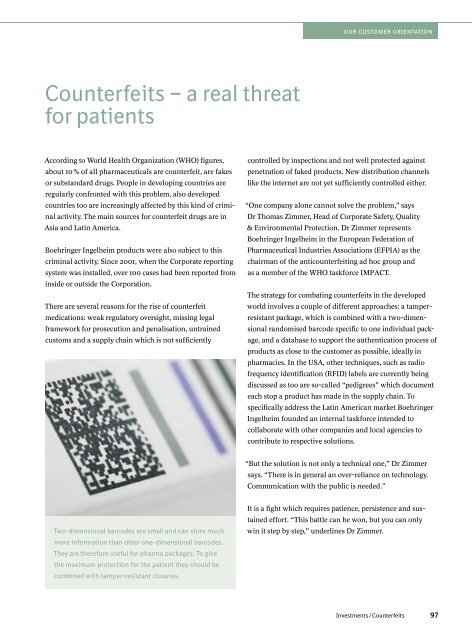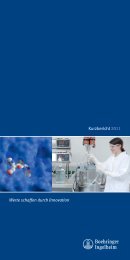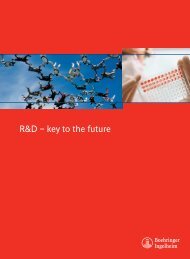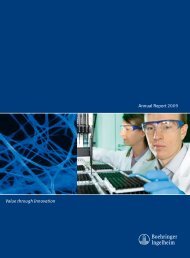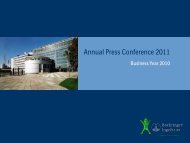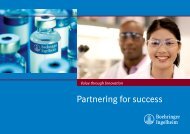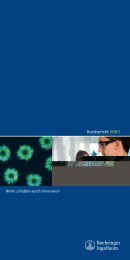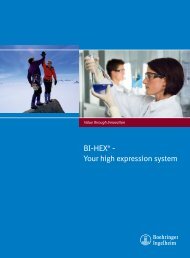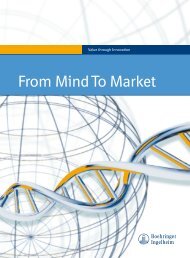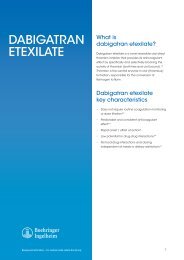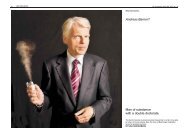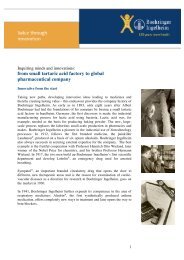Annual Report 2006 - Boehringer Ingelheim
Annual Report 2006 - Boehringer Ingelheim
Annual Report 2006 - Boehringer Ingelheim
Create successful ePaper yourself
Turn your PDF publications into a flip-book with our unique Google optimized e-Paper software.
Counterfeits – a real threat<br />
for patients<br />
According to World Health Organization (WHO) figures,<br />
about 10 % of all pharmaceuticals are counterfeit, are fakes<br />
or substandard drugs. People in developing countries are<br />
regularly confronted with this problem, also developed<br />
countries too are increasingly affected by this kind of crimi-<br />
nal activity. The main sources for counterfeit drugs are in<br />
Asia and Latin America.<br />
<strong>Boehringer</strong> <strong>Ingelheim</strong> products were also subject to this<br />
criminal activity. Since 2001, when the Corporate reporting<br />
system was installed, over 100 cases had been reported from<br />
inside or outside the Corporation.<br />
There are several reasons for the rise of counterfeit<br />
medications: weak regulatory oversight, missing legal<br />
framework for prosecution and penalisation, untrained<br />
customs and a supply chain which is not sufficiently<br />
Two-dimensional barcodes are small and can store much<br />
more information than older one-dimensional barcodes.<br />
They are therefore useful for pharma packages. To give<br />
the maximum protection for the patient they should be<br />
combined with tamper-resistant closures.<br />
our customer orientation<br />
controlled by inspections and not well protected against<br />
penetration of faked products. New distribution channels<br />
like the internet are not yet sufficiently controlled either.<br />
“One company alone cannot solve the problem,” says<br />
Dr Thomas Zimmer, Head of Corporate Safety, Quality<br />
& Environmental Protection. Dr Zimmer represents<br />
<strong>Boehringer</strong> <strong>Ingelheim</strong> in the European Federation of<br />
Pharmaceutical Industries Associations (EFPIA) as the<br />
chairman of the anticounterfeiting ad hoc group and<br />
as a member of the WHO taskforce IMPACT.<br />
The strategy for combating counterfeits in the developed<br />
world involves a couple of different approaches: a tamper-<br />
resistant package, which is combined with a two-dimen-<br />
sional randomised barcode specific to one individual pack-<br />
age, and a database to support the authentication process of<br />
products as close to the customer as possible, ideally in<br />
pharmacies. In the USA, other techniques, such as radio<br />
frequency identification (RFID) labels are currently being<br />
discussed as too are so-called “pedigrees” which document<br />
each stop a product has made in the supply chain. To<br />
specifically address the Latin American market <strong>Boehringer</strong><br />
<strong>Ingelheim</strong> founded an internal taskforce intended to<br />
collaborate with other companies and local agencies to<br />
contribute to respective solutions.<br />
“But the solution is not only a technical one,” Dr Zimmer<br />
says. “There is in general an over-reliance on technology.<br />
Communication with the public is needed.”<br />
It is a fight which requires patience, persistence and sustained<br />
effort. “This battle can be won, but you can only<br />
win it step by step,” underlines Dr Zimmer.<br />
Investments / Counterfeits<br />
9


